HRM Strategies at NHS: Internal Environment, Effectiveness, and Theoretical Strategies
VerifiedAdded on 2023/06/17
|11
|3708
|373
AI Summary
This essay discusses the micro or internal environment of NHS, HRM strategies, their effectiveness, theoretical HRM strategies, and the impact of globalisation and international forces on NHS’s HRM strategy.
Contribute Materials
Your contribution can guide someone’s learning journey. Share your
documents today.
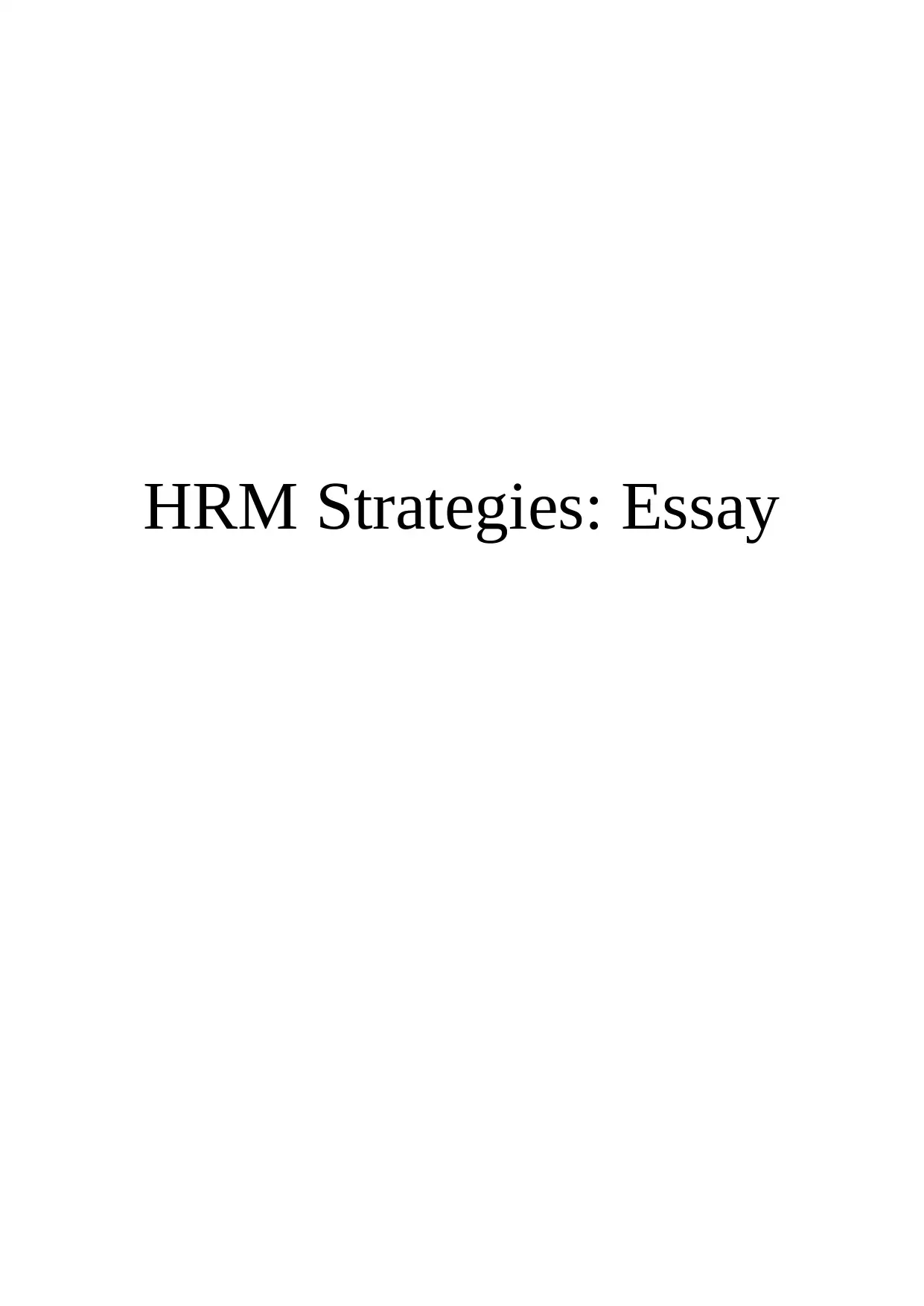
HRM Strategies: Essay
Secure Best Marks with AI Grader
Need help grading? Try our AI Grader for instant feedback on your assignments.
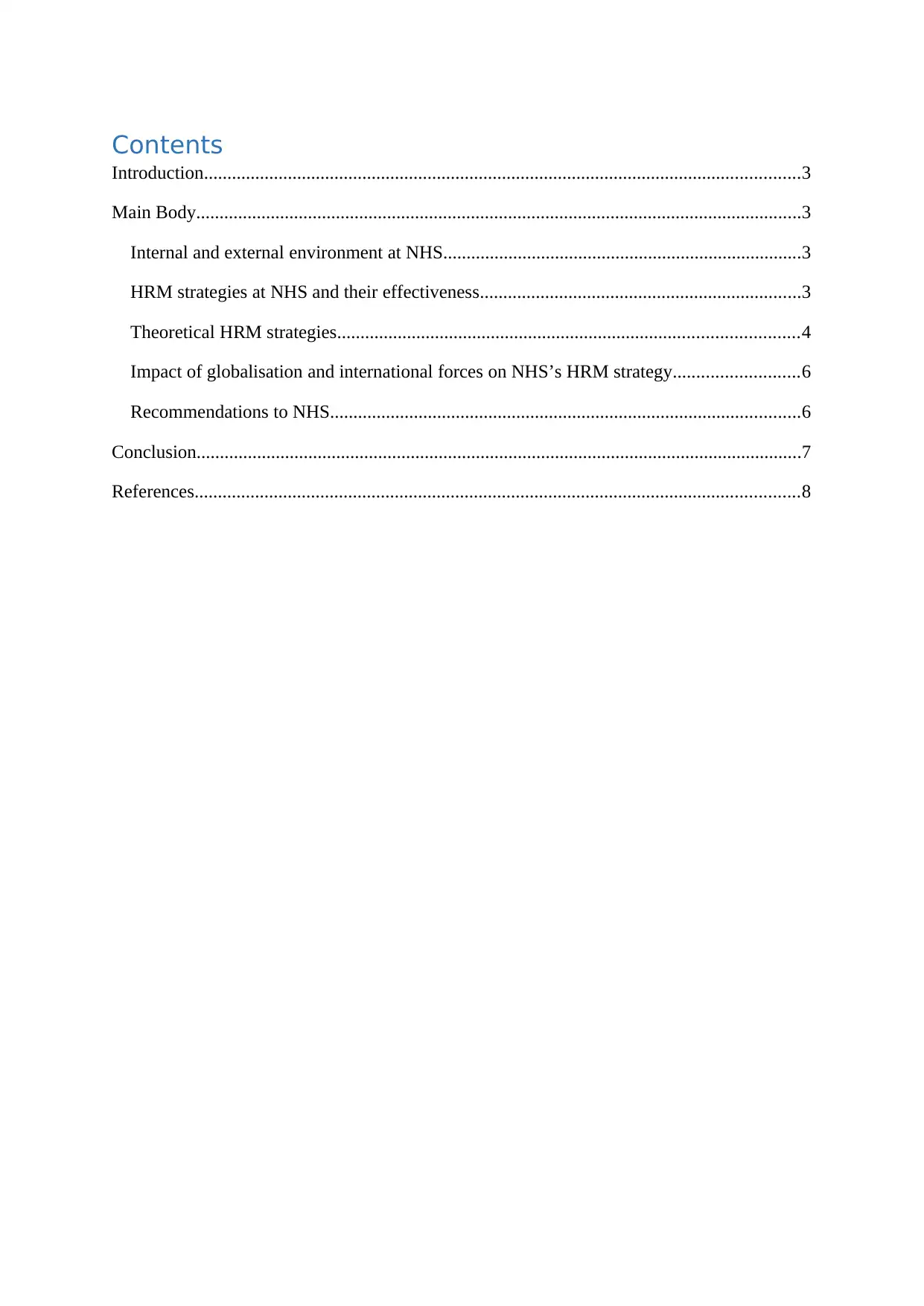
Contents
Introduction................................................................................................................................3
Main Body..................................................................................................................................3
Internal and external environment at NHS.............................................................................3
HRM strategies at NHS and their effectiveness.....................................................................3
Theoretical HRM strategies...................................................................................................4
Impact of globalisation and international forces on NHS’s HRM strategy...........................6
Recommendations to NHS.....................................................................................................6
Conclusion..................................................................................................................................7
References..................................................................................................................................8
Introduction................................................................................................................................3
Main Body..................................................................................................................................3
Internal and external environment at NHS.............................................................................3
HRM strategies at NHS and their effectiveness.....................................................................3
Theoretical HRM strategies...................................................................................................4
Impact of globalisation and international forces on NHS’s HRM strategy...........................6
Recommendations to NHS.....................................................................................................6
Conclusion..................................................................................................................................7
References..................................................................................................................................8
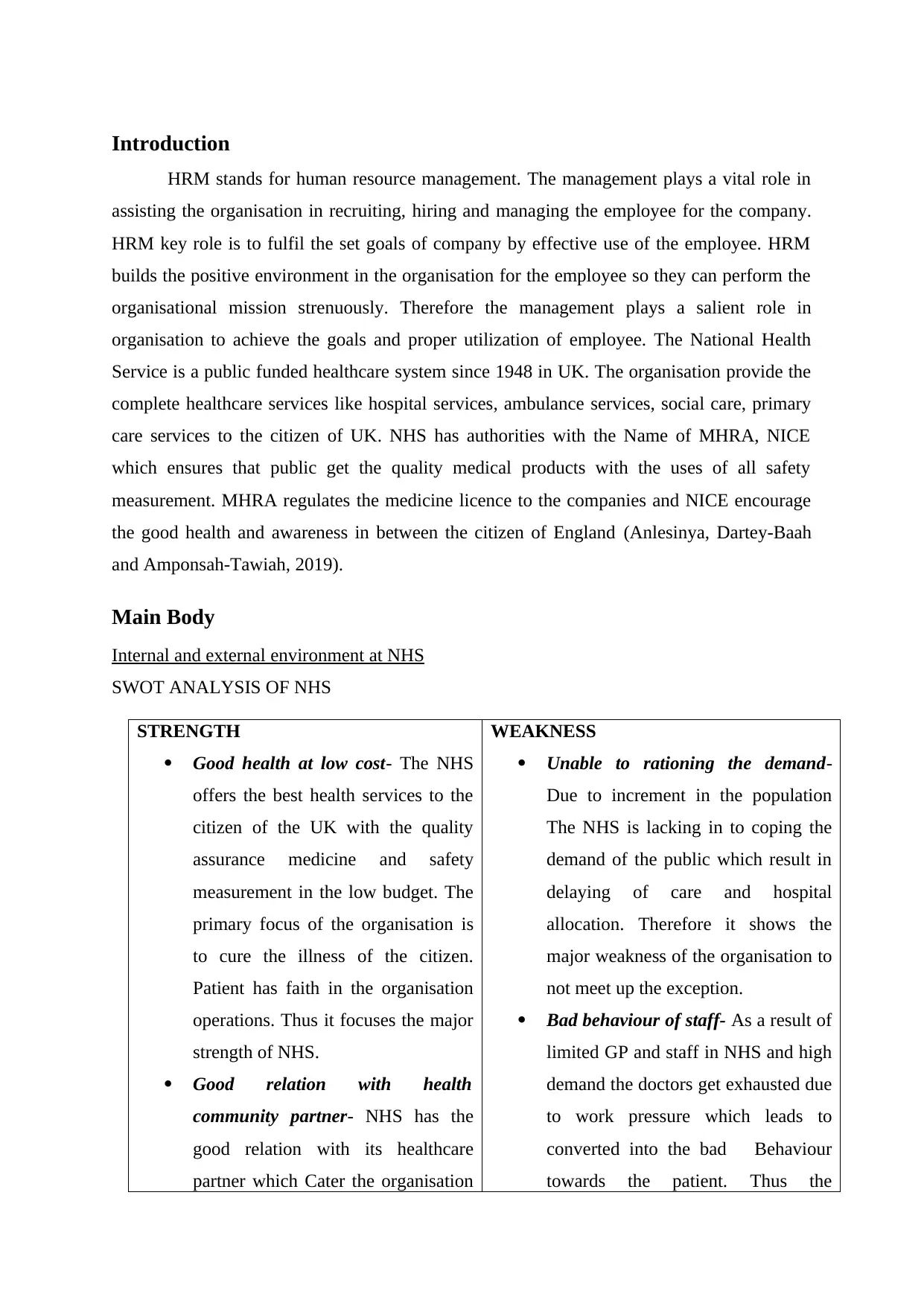
Introduction
HRM stands for human resource management. The management plays a vital role in
assisting the organisation in recruiting, hiring and managing the employee for the company.
HRM key role is to fulfil the set goals of company by effective use of the employee. HRM
builds the positive environment in the organisation for the employee so they can perform the
organisational mission strenuously. Therefore the management plays a salient role in
organisation to achieve the goals and proper utilization of employee. The National Health
Service is a public funded healthcare system since 1948 in UK. The organisation provide the
complete healthcare services like hospital services, ambulance services, social care, primary
care services to the citizen of UK. NHS has authorities with the Name of MHRA, NICE
which ensures that public get the quality medical products with the uses of all safety
measurement. MHRA regulates the medicine licence to the companies and NICE encourage
the good health and awareness in between the citizen of England (Anlesinya, Dartey-Baah
and Amponsah-Tawiah, 2019).
Main Body
Internal and external environment at NHS
SWOT ANALYSIS OF NHS
STRENGTH
Good health at low cost- The NHS
offers the best health services to the
citizen of the UK with the quality
assurance medicine and safety
measurement in the low budget. The
primary focus of the organisation is
to cure the illness of the citizen.
Patient has faith in the organisation
operations. Thus it focuses the major
strength of NHS.
Good relation with health
community partner- NHS has the
good relation with its healthcare
partner which Cater the organisation
WEAKNESS
Unable to rationing the demand-
Due to increment in the population
The NHS is lacking in to coping the
demand of the public which result in
delaying of care and hospital
allocation. Therefore it shows the
major weakness of the organisation to
not meet up the exception.
Bad behaviour of staff- As a result of
limited GP and staff in NHS and high
demand the doctors get exhausted due
to work pressure which leads to
converted into the bad Behaviour
towards the patient. Thus the
HRM stands for human resource management. The management plays a vital role in
assisting the organisation in recruiting, hiring and managing the employee for the company.
HRM key role is to fulfil the set goals of company by effective use of the employee. HRM
builds the positive environment in the organisation for the employee so they can perform the
organisational mission strenuously. Therefore the management plays a salient role in
organisation to achieve the goals and proper utilization of employee. The National Health
Service is a public funded healthcare system since 1948 in UK. The organisation provide the
complete healthcare services like hospital services, ambulance services, social care, primary
care services to the citizen of UK. NHS has authorities with the Name of MHRA, NICE
which ensures that public get the quality medical products with the uses of all safety
measurement. MHRA regulates the medicine licence to the companies and NICE encourage
the good health and awareness in between the citizen of England (Anlesinya, Dartey-Baah
and Amponsah-Tawiah, 2019).
Main Body
Internal and external environment at NHS
SWOT ANALYSIS OF NHS
STRENGTH
Good health at low cost- The NHS
offers the best health services to the
citizen of the UK with the quality
assurance medicine and safety
measurement in the low budget. The
primary focus of the organisation is
to cure the illness of the citizen.
Patient has faith in the organisation
operations. Thus it focuses the major
strength of NHS.
Good relation with health
community partner- NHS has the
good relation with its healthcare
partner which Cater the organisation
WEAKNESS
Unable to rationing the demand-
Due to increment in the population
The NHS is lacking in to coping the
demand of the public which result in
delaying of care and hospital
allocation. Therefore it shows the
major weakness of the organisation to
not meet up the exception.
Bad behaviour of staff- As a result of
limited GP and staff in NHS and high
demand the doctors get exhausted due
to work pressure which leads to
converted into the bad Behaviour
towards the patient. Thus the
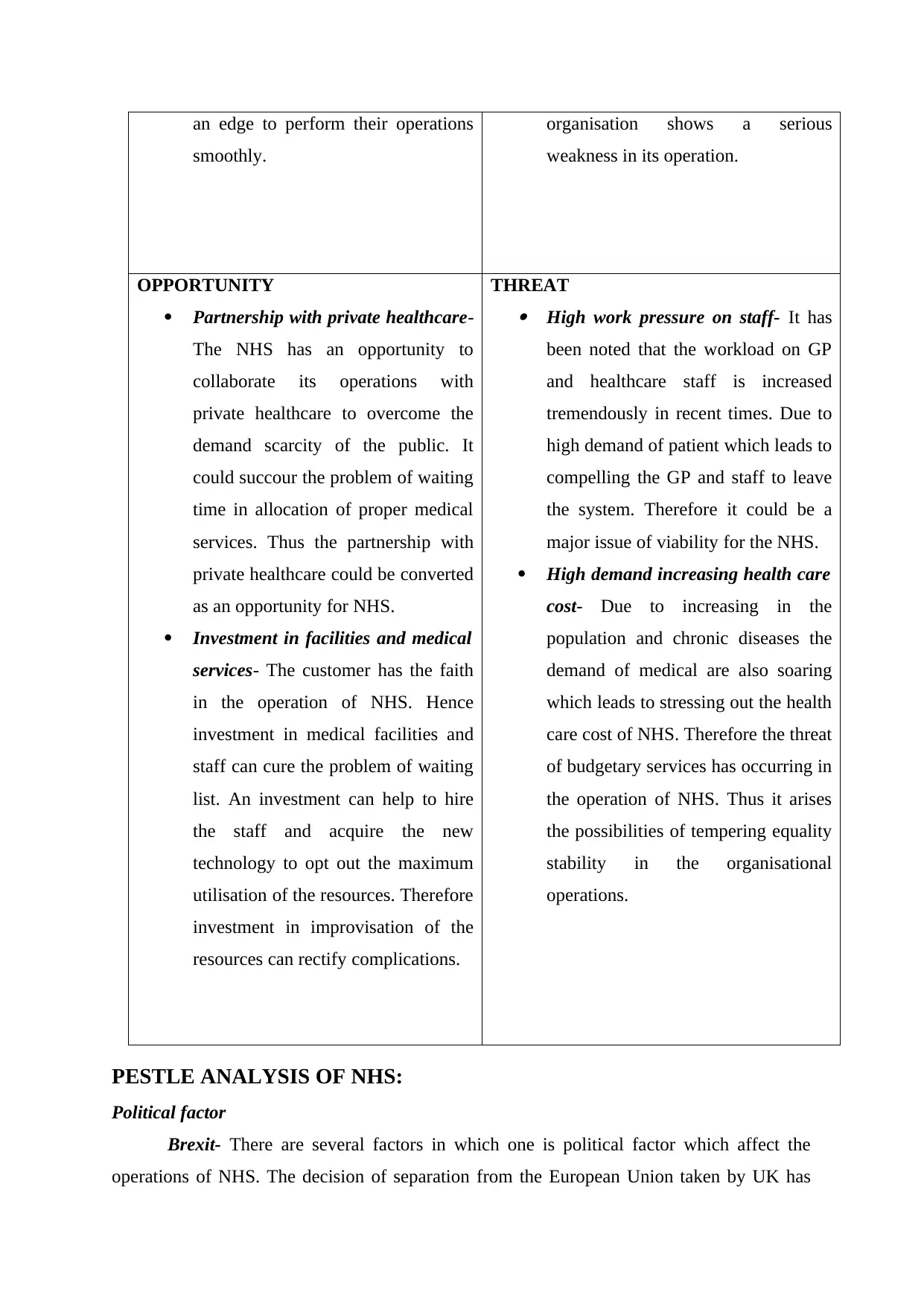
an edge to perform their operations
smoothly.
organisation shows a serious
weakness in its operation.
OPPORTUNITY
Partnership with private healthcare-
The NHS has an opportunity to
collaborate its operations with
private healthcare to overcome the
demand scarcity of the public. It
could succour the problem of waiting
time in allocation of proper medical
services. Thus the partnership with
private healthcare could be converted
as an opportunity for NHS.
Investment in facilities and medical
services- The customer has the faith
in the operation of NHS. Hence
investment in medical facilities and
staff can cure the problem of waiting
list. An investment can help to hire
the staff and acquire the new
technology to opt out the maximum
utilisation of the resources. Therefore
investment in improvisation of the
resources can rectify complications.
THREAT
High work pressure on staff- It has
been noted that the workload on GP
and healthcare staff is increased
tremendously in recent times. Due to
high demand of patient which leads to
compelling the GP and staff to leave
the system. Therefore it could be a
major issue of viability for the NHS.
High demand increasing health care
cost- Due to increasing in the
population and chronic diseases the
demand of medical are also soaring
which leads to stressing out the health
care cost of NHS. Therefore the threat
of budgetary services has occurring in
the operation of NHS. Thus it arises
the possibilities of tempering equality
stability in the organisational
operations.
PESTLE ANALYSIS OF NHS:
Political factor
Brexit- There are several factors in which one is political factor which affect the
operations of NHS. The decision of separation from the European Union taken by UK has
smoothly.
organisation shows a serious
weakness in its operation.
OPPORTUNITY
Partnership with private healthcare-
The NHS has an opportunity to
collaborate its operations with
private healthcare to overcome the
demand scarcity of the public. It
could succour the problem of waiting
time in allocation of proper medical
services. Thus the partnership with
private healthcare could be converted
as an opportunity for NHS.
Investment in facilities and medical
services- The customer has the faith
in the operation of NHS. Hence
investment in medical facilities and
staff can cure the problem of waiting
list. An investment can help to hire
the staff and acquire the new
technology to opt out the maximum
utilisation of the resources. Therefore
investment in improvisation of the
resources can rectify complications.
THREAT
High work pressure on staff- It has
been noted that the workload on GP
and healthcare staff is increased
tremendously in recent times. Due to
high demand of patient which leads to
compelling the GP and staff to leave
the system. Therefore it could be a
major issue of viability for the NHS.
High demand increasing health care
cost- Due to increasing in the
population and chronic diseases the
demand of medical are also soaring
which leads to stressing out the health
care cost of NHS. Therefore the threat
of budgetary services has occurring in
the operation of NHS. Thus it arises
the possibilities of tempering equality
stability in the organisational
operations.
PESTLE ANALYSIS OF NHS:
Political factor
Brexit- There are several factors in which one is political factor which affect the
operations of NHS. The decision of separation from the European Union taken by UK has
Secure Best Marks with AI Grader
Need help grading? Try our AI Grader for instant feedback on your assignments.
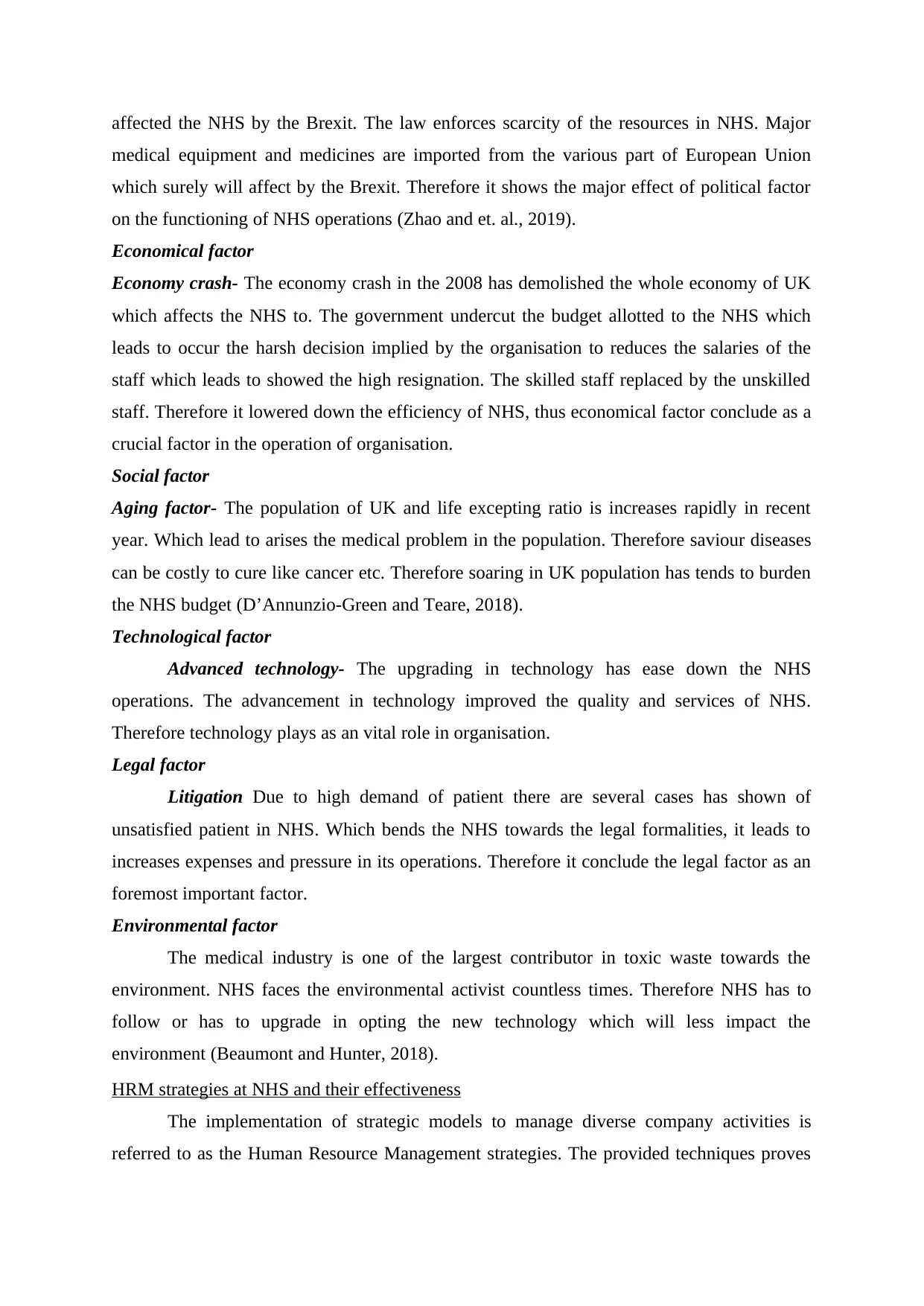
affected the NHS by the Brexit. The law enforces scarcity of the resources in NHS. Major
medical equipment and medicines are imported from the various part of European Union
which surely will affect by the Brexit. Therefore it shows the major effect of political factor
on the functioning of NHS operations (Zhao and et. al., 2019).
Economical factor
Economy crash- The economy crash in the 2008 has demolished the whole economy of UK
which affects the NHS to. The government undercut the budget allotted to the NHS which
leads to occur the harsh decision implied by the organisation to reduces the salaries of the
staff which leads to showed the high resignation. The skilled staff replaced by the unskilled
staff. Therefore it lowered down the efficiency of NHS, thus economical factor conclude as a
crucial factor in the operation of organisation.
Social factor
Aging factor- The population of UK and life excepting ratio is increases rapidly in recent
year. Which lead to arises the medical problem in the population. Therefore saviour diseases
can be costly to cure like cancer etc. Therefore soaring in UK population has tends to burden
the NHS budget (D’Annunzio-Green and Teare, 2018).
Technological factor
Advanced technology- The upgrading in technology has ease down the NHS
operations. The advancement in technology improved the quality and services of NHS.
Therefore technology plays as an vital role in organisation.
Legal factor
Litigation Due to high demand of patient there are several cases has shown of
unsatisfied patient in NHS. Which bends the NHS towards the legal formalities, it leads to
increases expenses and pressure in its operations. Therefore it conclude the legal factor as an
foremost important factor.
Environmental factor
The medical industry is one of the largest contributor in toxic waste towards the
environment. NHS faces the environmental activist countless times. Therefore NHS has to
follow or has to upgrade in opting the new technology which will less impact the
environment (Beaumont and Hunter, 2018).
HRM strategies at NHS and their effectiveness
The implementation of strategic models to manage diverse company activities is
referred to as the Human Resource Management strategies. The provided techniques proves
medical equipment and medicines are imported from the various part of European Union
which surely will affect by the Brexit. Therefore it shows the major effect of political factor
on the functioning of NHS operations (Zhao and et. al., 2019).
Economical factor
Economy crash- The economy crash in the 2008 has demolished the whole economy of UK
which affects the NHS to. The government undercut the budget allotted to the NHS which
leads to occur the harsh decision implied by the organisation to reduces the salaries of the
staff which leads to showed the high resignation. The skilled staff replaced by the unskilled
staff. Therefore it lowered down the efficiency of NHS, thus economical factor conclude as a
crucial factor in the operation of organisation.
Social factor
Aging factor- The population of UK and life excepting ratio is increases rapidly in recent
year. Which lead to arises the medical problem in the population. Therefore saviour diseases
can be costly to cure like cancer etc. Therefore soaring in UK population has tends to burden
the NHS budget (D’Annunzio-Green and Teare, 2018).
Technological factor
Advanced technology- The upgrading in technology has ease down the NHS
operations. The advancement in technology improved the quality and services of NHS.
Therefore technology plays as an vital role in organisation.
Legal factor
Litigation Due to high demand of patient there are several cases has shown of
unsatisfied patient in NHS. Which bends the NHS towards the legal formalities, it leads to
increases expenses and pressure in its operations. Therefore it conclude the legal factor as an
foremost important factor.
Environmental factor
The medical industry is one of the largest contributor in toxic waste towards the
environment. NHS faces the environmental activist countless times. Therefore NHS has to
follow or has to upgrade in opting the new technology which will less impact the
environment (Beaumont and Hunter, 2018).
HRM strategies at NHS and their effectiveness
The implementation of strategic models to manage diverse company activities is
referred to as the Human Resource Management strategies. The provided techniques proves
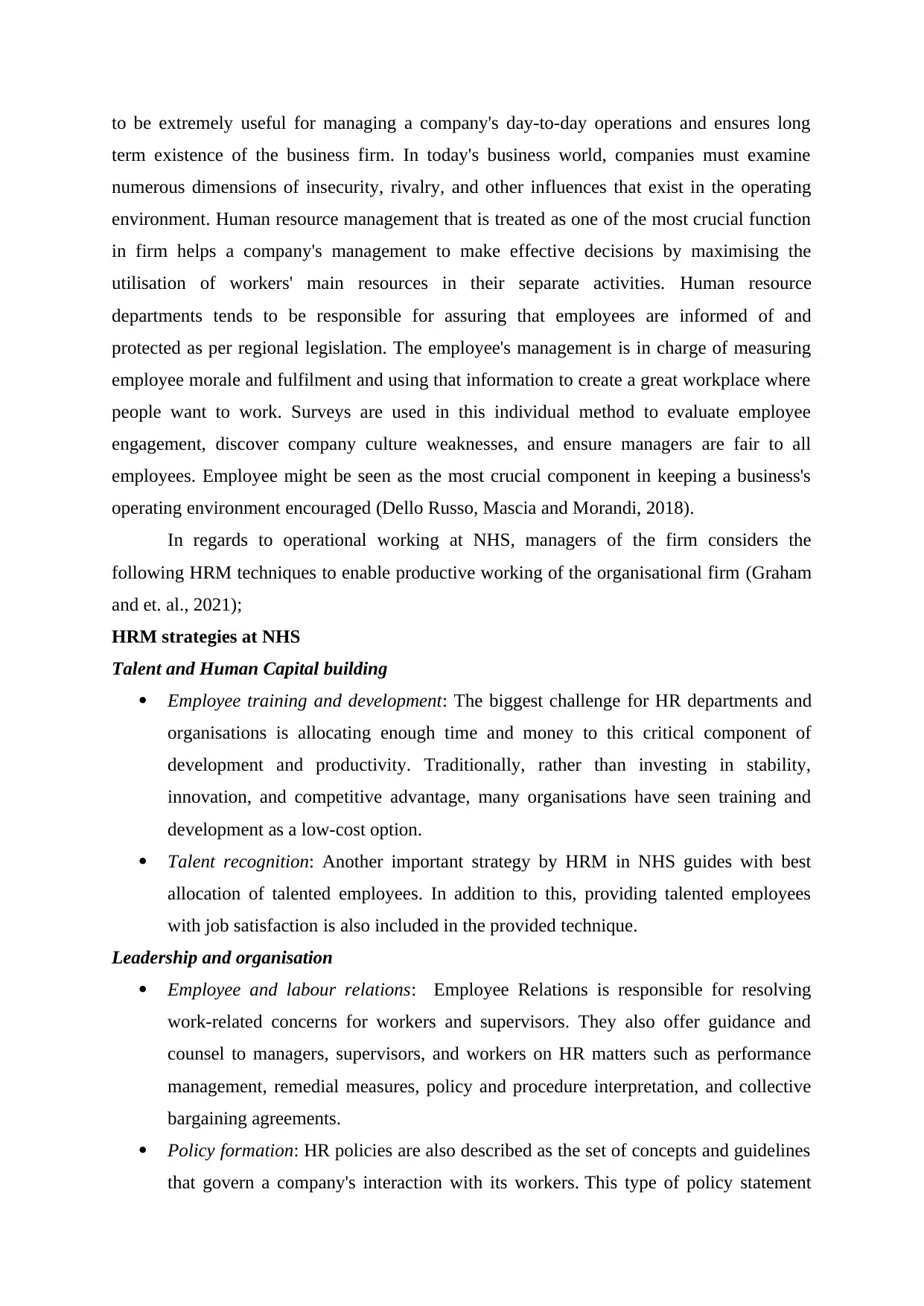
to be extremely useful for managing a company's day-to-day operations and ensures long
term existence of the business firm. In today's business world, companies must examine
numerous dimensions of insecurity, rivalry, and other influences that exist in the operating
environment. Human resource management that is treated as one of the most crucial function
in firm helps a company's management to make effective decisions by maximising the
utilisation of workers' main resources in their separate activities. Human resource
departments tends to be responsible for assuring that employees are informed of and
protected as per regional legislation. The employee's management is in charge of measuring
employee morale and fulfilment and using that information to create a great workplace where
people want to work. Surveys are used in this individual method to evaluate employee
engagement, discover company culture weaknesses, and ensure managers are fair to all
employees. Employee might be seen as the most crucial component in keeping a business's
operating environment encouraged (Dello Russo, Mascia and Morandi, 2018).
In regards to operational working at NHS, managers of the firm considers the
following HRM techniques to enable productive working of the organisational firm (Graham
and et. al., 2021);
HRM strategies at NHS
Talent and Human Capital building
Employee training and development: The biggest challenge for HR departments and
organisations is allocating enough time and money to this critical component of
development and productivity. Traditionally, rather than investing in stability,
innovation, and competitive advantage, many organisations have seen training and
development as a low-cost option.
Talent recognition: Another important strategy by HRM in NHS guides with best
allocation of talented employees. In addition to this, providing talented employees
with job satisfaction is also included in the provided technique.
Leadership and organisation
Employee and labour relations: Employee Relations is responsible for resolving
work-related concerns for workers and supervisors. They also offer guidance and
counsel to managers, supervisors, and workers on HR matters such as performance
management, remedial measures, policy and procedure interpretation, and collective
bargaining agreements.
Policy formation: HR policies are also described as the set of concepts and guidelines
that govern a company's interaction with its workers. This type of policy statement
term existence of the business firm. In today's business world, companies must examine
numerous dimensions of insecurity, rivalry, and other influences that exist in the operating
environment. Human resource management that is treated as one of the most crucial function
in firm helps a company's management to make effective decisions by maximising the
utilisation of workers' main resources in their separate activities. Human resource
departments tends to be responsible for assuring that employees are informed of and
protected as per regional legislation. The employee's management is in charge of measuring
employee morale and fulfilment and using that information to create a great workplace where
people want to work. Surveys are used in this individual method to evaluate employee
engagement, discover company culture weaknesses, and ensure managers are fair to all
employees. Employee might be seen as the most crucial component in keeping a business's
operating environment encouraged (Dello Russo, Mascia and Morandi, 2018).
In regards to operational working at NHS, managers of the firm considers the
following HRM techniques to enable productive working of the organisational firm (Graham
and et. al., 2021);
HRM strategies at NHS
Talent and Human Capital building
Employee training and development: The biggest challenge for HR departments and
organisations is allocating enough time and money to this critical component of
development and productivity. Traditionally, rather than investing in stability,
innovation, and competitive advantage, many organisations have seen training and
development as a low-cost option.
Talent recognition: Another important strategy by HRM in NHS guides with best
allocation of talented employees. In addition to this, providing talented employees
with job satisfaction is also included in the provided technique.
Leadership and organisation
Employee and labour relations: Employee Relations is responsible for resolving
work-related concerns for workers and supervisors. They also offer guidance and
counsel to managers, supervisors, and workers on HR matters such as performance
management, remedial measures, policy and procedure interpretation, and collective
bargaining agreements.
Policy formation: HR policies are also described as the set of concepts and guidelines
that govern a company's interaction with its workers. This type of policy statement
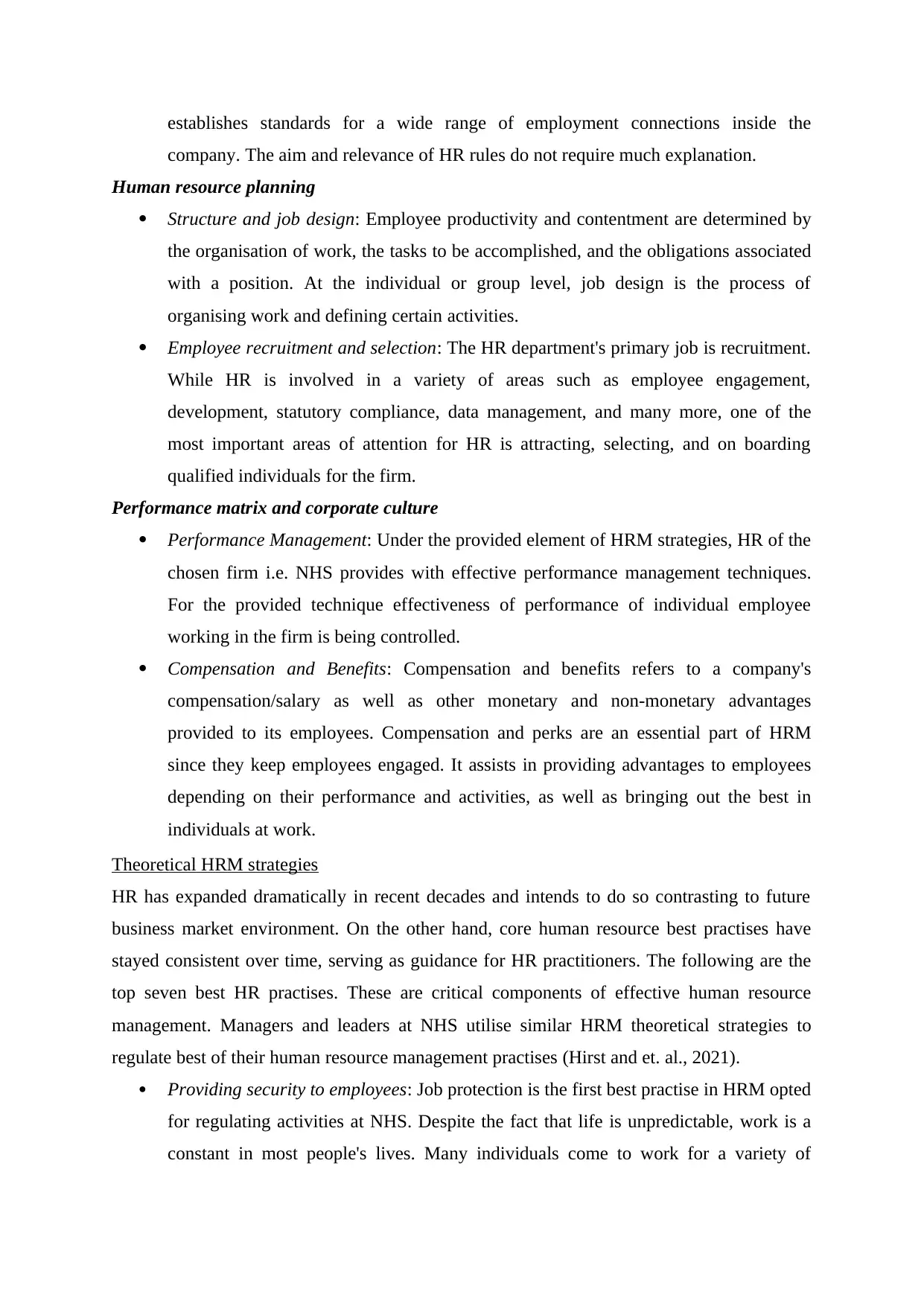
establishes standards for a wide range of employment connections inside the
company. The aim and relevance of HR rules do not require much explanation.
Human resource planning
Structure and job design: Employee productivity and contentment are determined by
the organisation of work, the tasks to be accomplished, and the obligations associated
with a position. At the individual or group level, job design is the process of
organising work and defining certain activities.
Employee recruitment and selection: The HR department's primary job is recruitment.
While HR is involved in a variety of areas such as employee engagement,
development, statutory compliance, data management, and many more, one of the
most important areas of attention for HR is attracting, selecting, and on boarding
qualified individuals for the firm.
Performance matrix and corporate culture
Performance Management: Under the provided element of HRM strategies, HR of the
chosen firm i.e. NHS provides with effective performance management techniques.
For the provided technique effectiveness of performance of individual employee
working in the firm is being controlled.
Compensation and Benefits: Compensation and benefits refers to a company's
compensation/salary as well as other monetary and non-monetary advantages
provided to its employees. Compensation and perks are an essential part of HRM
since they keep employees engaged. It assists in providing advantages to employees
depending on their performance and activities, as well as bringing out the best in
individuals at work.
Theoretical HRM strategies
HR has expanded dramatically in recent decades and intends to do so contrasting to future
business market environment. On the other hand, core human resource best practises have
stayed consistent over time, serving as guidance for HR practitioners. The following are the
top seven best HR practises. These are critical components of effective human resource
management. Managers and leaders at NHS utilise similar HRM theoretical strategies to
regulate best of their human resource management practises (Hirst and et. al., 2021).
Providing security to employees: Job protection is the first best practise in HRM opted
for regulating activities at NHS. Despite the fact that life is unpredictable, work is a
constant in most people's lives. Many individuals come to work for a variety of
company. The aim and relevance of HR rules do not require much explanation.
Human resource planning
Structure and job design: Employee productivity and contentment are determined by
the organisation of work, the tasks to be accomplished, and the obligations associated
with a position. At the individual or group level, job design is the process of
organising work and defining certain activities.
Employee recruitment and selection: The HR department's primary job is recruitment.
While HR is involved in a variety of areas such as employee engagement,
development, statutory compliance, data management, and many more, one of the
most important areas of attention for HR is attracting, selecting, and on boarding
qualified individuals for the firm.
Performance matrix and corporate culture
Performance Management: Under the provided element of HRM strategies, HR of the
chosen firm i.e. NHS provides with effective performance management techniques.
For the provided technique effectiveness of performance of individual employee
working in the firm is being controlled.
Compensation and Benefits: Compensation and benefits refers to a company's
compensation/salary as well as other monetary and non-monetary advantages
provided to its employees. Compensation and perks are an essential part of HRM
since they keep employees engaged. It assists in providing advantages to employees
depending on their performance and activities, as well as bringing out the best in
individuals at work.
Theoretical HRM strategies
HR has expanded dramatically in recent decades and intends to do so contrasting to future
business market environment. On the other hand, core human resource best practises have
stayed consistent over time, serving as guidance for HR practitioners. The following are the
top seven best HR practises. These are critical components of effective human resource
management. Managers and leaders at NHS utilise similar HRM theoretical strategies to
regulate best of their human resource management practises (Hirst and et. al., 2021).
Providing security to employees: Job protection is the first best practise in HRM opted
for regulating activities at NHS. Despite the fact that life is unpredictable, work is a
constant in most people's lives. Many individuals come to work for a variety of
Paraphrase This Document
Need a fresh take? Get an instant paraphrase of this document with our AI Paraphraser
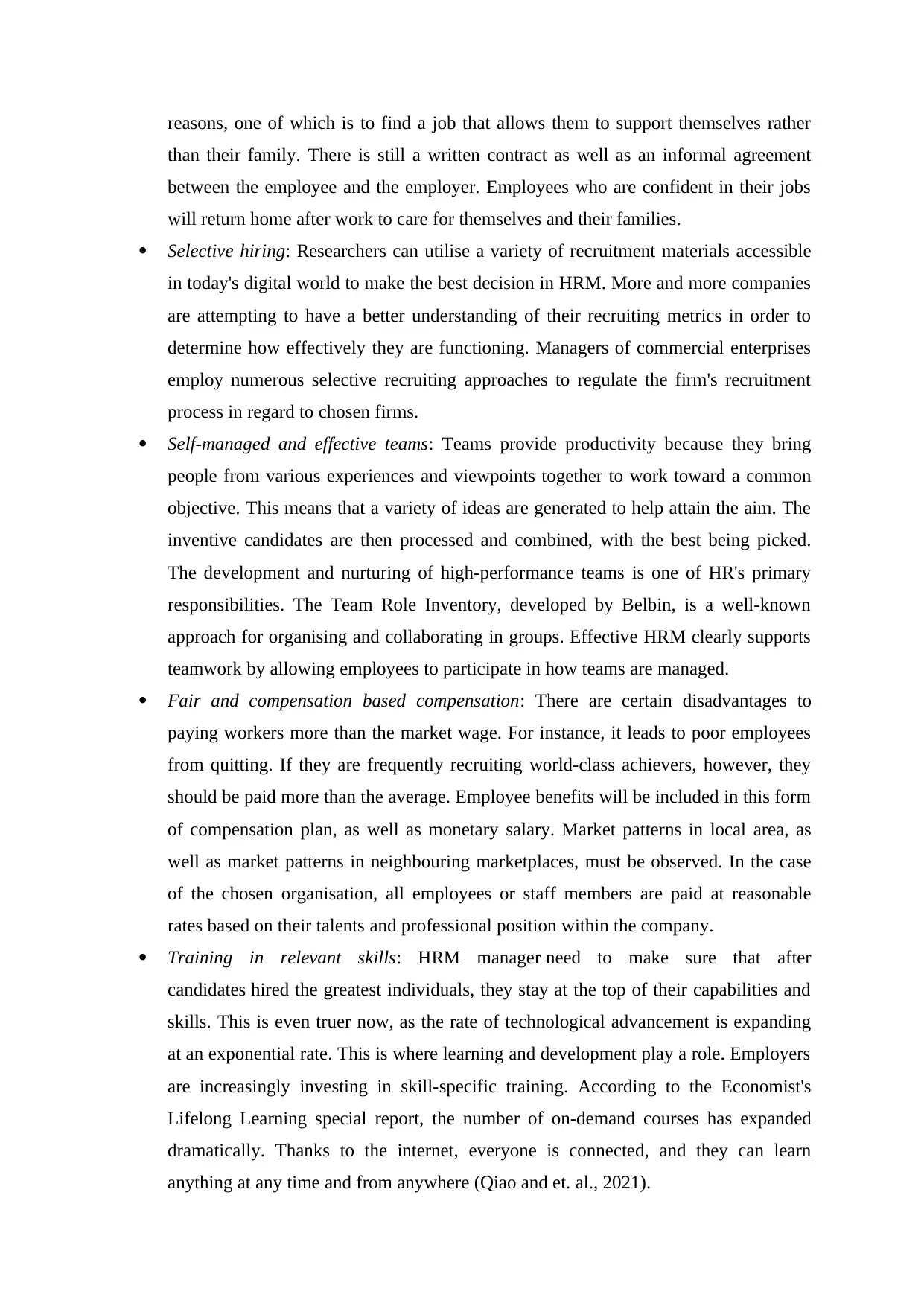
reasons, one of which is to find a job that allows them to support themselves rather
than their family. There is still a written contract as well as an informal agreement
between the employee and the employer. Employees who are confident in their jobs
will return home after work to care for themselves and their families.
Selective hiring: Researchers can utilise a variety of recruitment materials accessible
in today's digital world to make the best decision in HRM. More and more companies
are attempting to have a better understanding of their recruiting metrics in order to
determine how effectively they are functioning. Managers of commercial enterprises
employ numerous selective recruiting approaches to regulate the firm's recruitment
process in regard to chosen firms.
Self-managed and effective teams: Teams provide productivity because they bring
people from various experiences and viewpoints together to work toward a common
objective. This means that a variety of ideas are generated to help attain the aim. The
inventive candidates are then processed and combined, with the best being picked.
The development and nurturing of high-performance teams is one of HR's primary
responsibilities. The Team Role Inventory, developed by Belbin, is a well-known
approach for organising and collaborating in groups. Effective HRM clearly supports
teamwork by allowing employees to participate in how teams are managed.
Fair and compensation based compensation: There are certain disadvantages to
paying workers more than the market wage. For instance, it leads to poor employees
from quitting. If they are frequently recruiting world-class achievers, however, they
should be paid more than the average. Employee benefits will be included in this form
of compensation plan, as well as monetary salary. Market patterns in local area, as
well as market patterns in neighbouring marketplaces, must be observed. In the case
of the chosen organisation, all employees or staff members are paid at reasonable
rates based on their talents and professional position within the company.
Training in relevant skills: HRM manager need to make sure that after
candidates hired the greatest individuals, they stay at the top of their capabilities and
skills. This is even truer now, as the rate of technological advancement is expanding
at an exponential rate. This is where learning and development play a role. Employers
are increasingly investing in skill-specific training. According to the Economist's
Lifelong Learning special report, the number of on-demand courses has expanded
dramatically. Thanks to the internet, everyone is connected, and they can learn
anything at any time and from anywhere (Qiao and et. al., 2021).
than their family. There is still a written contract as well as an informal agreement
between the employee and the employer. Employees who are confident in their jobs
will return home after work to care for themselves and their families.
Selective hiring: Researchers can utilise a variety of recruitment materials accessible
in today's digital world to make the best decision in HRM. More and more companies
are attempting to have a better understanding of their recruiting metrics in order to
determine how effectively they are functioning. Managers of commercial enterprises
employ numerous selective recruiting approaches to regulate the firm's recruitment
process in regard to chosen firms.
Self-managed and effective teams: Teams provide productivity because they bring
people from various experiences and viewpoints together to work toward a common
objective. This means that a variety of ideas are generated to help attain the aim. The
inventive candidates are then processed and combined, with the best being picked.
The development and nurturing of high-performance teams is one of HR's primary
responsibilities. The Team Role Inventory, developed by Belbin, is a well-known
approach for organising and collaborating in groups. Effective HRM clearly supports
teamwork by allowing employees to participate in how teams are managed.
Fair and compensation based compensation: There are certain disadvantages to
paying workers more than the market wage. For instance, it leads to poor employees
from quitting. If they are frequently recruiting world-class achievers, however, they
should be paid more than the average. Employee benefits will be included in this form
of compensation plan, as well as monetary salary. Market patterns in local area, as
well as market patterns in neighbouring marketplaces, must be observed. In the case
of the chosen organisation, all employees or staff members are paid at reasonable
rates based on their talents and professional position within the company.
Training in relevant skills: HRM manager need to make sure that after
candidates hired the greatest individuals, they stay at the top of their capabilities and
skills. This is even truer now, as the rate of technological advancement is expanding
at an exponential rate. This is where learning and development play a role. Employers
are increasingly investing in skill-specific training. According to the Economist's
Lifelong Learning special report, the number of on-demand courses has expanded
dramatically. Thanks to the internet, everyone is connected, and they can learn
anything at any time and from anywhere (Qiao and et. al., 2021).
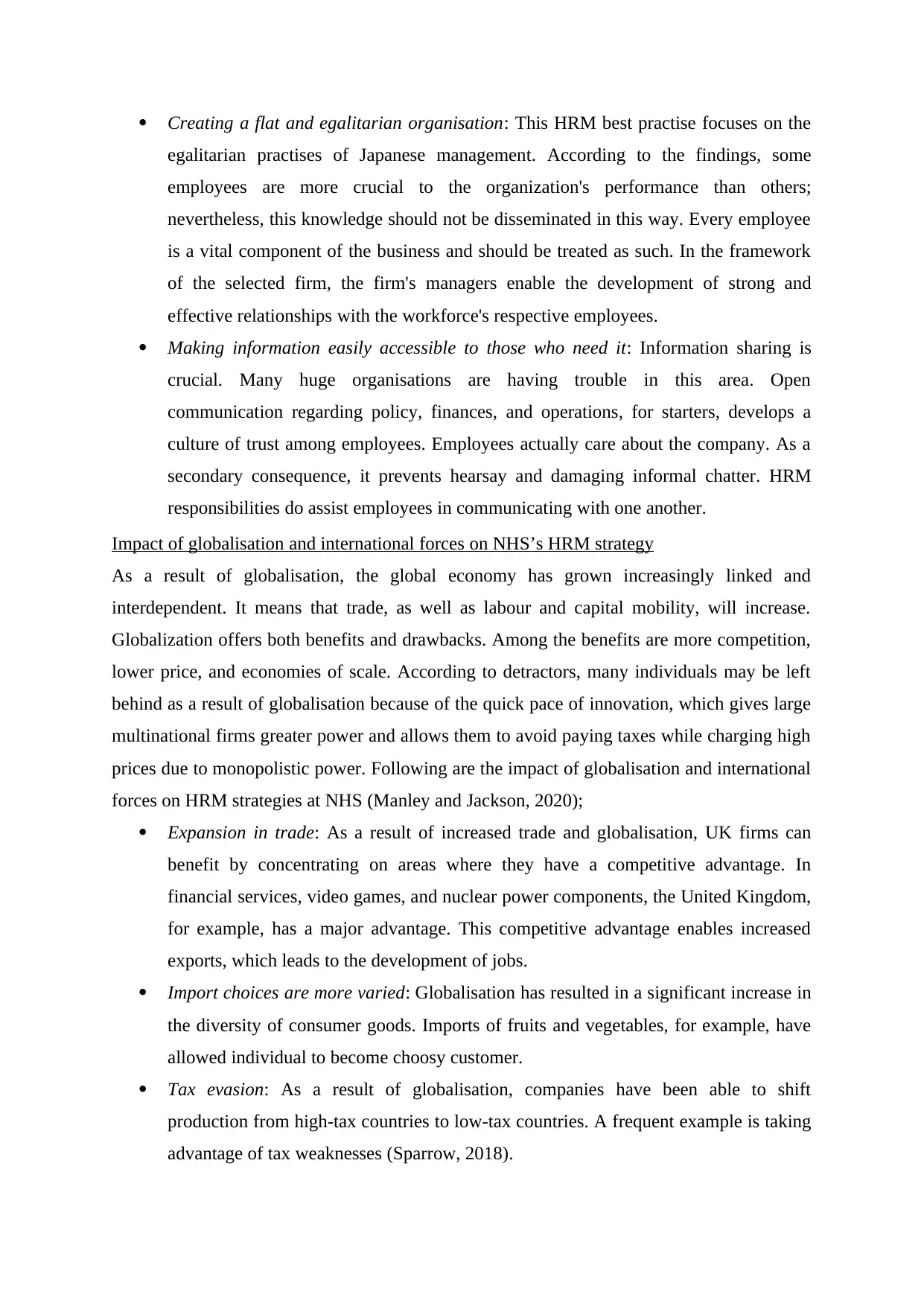
Creating a flat and egalitarian organisation: This HRM best practise focuses on the
egalitarian practises of Japanese management. According to the findings, some
employees are more crucial to the organization's performance than others;
nevertheless, this knowledge should not be disseminated in this way. Every employee
is a vital component of the business and should be treated as such. In the framework
of the selected firm, the firm's managers enable the development of strong and
effective relationships with the workforce's respective employees.
Making information easily accessible to those who need it: Information sharing is
crucial. Many huge organisations are having trouble in this area. Open
communication regarding policy, finances, and operations, for starters, develops a
culture of trust among employees. Employees actually care about the company. As a
secondary consequence, it prevents hearsay and damaging informal chatter. HRM
responsibilities do assist employees in communicating with one another.
Impact of globalisation and international forces on NHS’s HRM strategy
As a result of globalisation, the global economy has grown increasingly linked and
interdependent. It means that trade, as well as labour and capital mobility, will increase.
Globalization offers both benefits and drawbacks. Among the benefits are more competition,
lower price, and economies of scale. According to detractors, many individuals may be left
behind as a result of globalisation because of the quick pace of innovation, which gives large
multinational firms greater power and allows them to avoid paying taxes while charging high
prices due to monopolistic power. Following are the impact of globalisation and international
forces on HRM strategies at NHS (Manley and Jackson, 2020);
Expansion in trade: As a result of increased trade and globalisation, UK firms can
benefit by concentrating on areas where they have a competitive advantage. In
financial services, video games, and nuclear power components, the United Kingdom,
for example, has a major advantage. This competitive advantage enables increased
exports, which leads to the development of jobs.
Import choices are more varied: Globalisation has resulted in a significant increase in
the diversity of consumer goods. Imports of fruits and vegetables, for example, have
allowed individual to become choosy customer.
Tax evasion: As a result of globalisation, companies have been able to shift
production from high-tax countries to low-tax countries. A frequent example is taking
advantage of tax weaknesses (Sparrow, 2018).
egalitarian practises of Japanese management. According to the findings, some
employees are more crucial to the organization's performance than others;
nevertheless, this knowledge should not be disseminated in this way. Every employee
is a vital component of the business and should be treated as such. In the framework
of the selected firm, the firm's managers enable the development of strong and
effective relationships with the workforce's respective employees.
Making information easily accessible to those who need it: Information sharing is
crucial. Many huge organisations are having trouble in this area. Open
communication regarding policy, finances, and operations, for starters, develops a
culture of trust among employees. Employees actually care about the company. As a
secondary consequence, it prevents hearsay and damaging informal chatter. HRM
responsibilities do assist employees in communicating with one another.
Impact of globalisation and international forces on NHS’s HRM strategy
As a result of globalisation, the global economy has grown increasingly linked and
interdependent. It means that trade, as well as labour and capital mobility, will increase.
Globalization offers both benefits and drawbacks. Among the benefits are more competition,
lower price, and economies of scale. According to detractors, many individuals may be left
behind as a result of globalisation because of the quick pace of innovation, which gives large
multinational firms greater power and allows them to avoid paying taxes while charging high
prices due to monopolistic power. Following are the impact of globalisation and international
forces on HRM strategies at NHS (Manley and Jackson, 2020);
Expansion in trade: As a result of increased trade and globalisation, UK firms can
benefit by concentrating on areas where they have a competitive advantage. In
financial services, video games, and nuclear power components, the United Kingdom,
for example, has a major advantage. This competitive advantage enables increased
exports, which leads to the development of jobs.
Import choices are more varied: Globalisation has resulted in a significant increase in
the diversity of consumer goods. Imports of fruits and vegetables, for example, have
allowed individual to become choosy customer.
Tax evasion: As a result of globalisation, companies have been able to shift
production from high-tax countries to low-tax countries. A frequent example is taking
advantage of tax weaknesses (Sparrow, 2018).
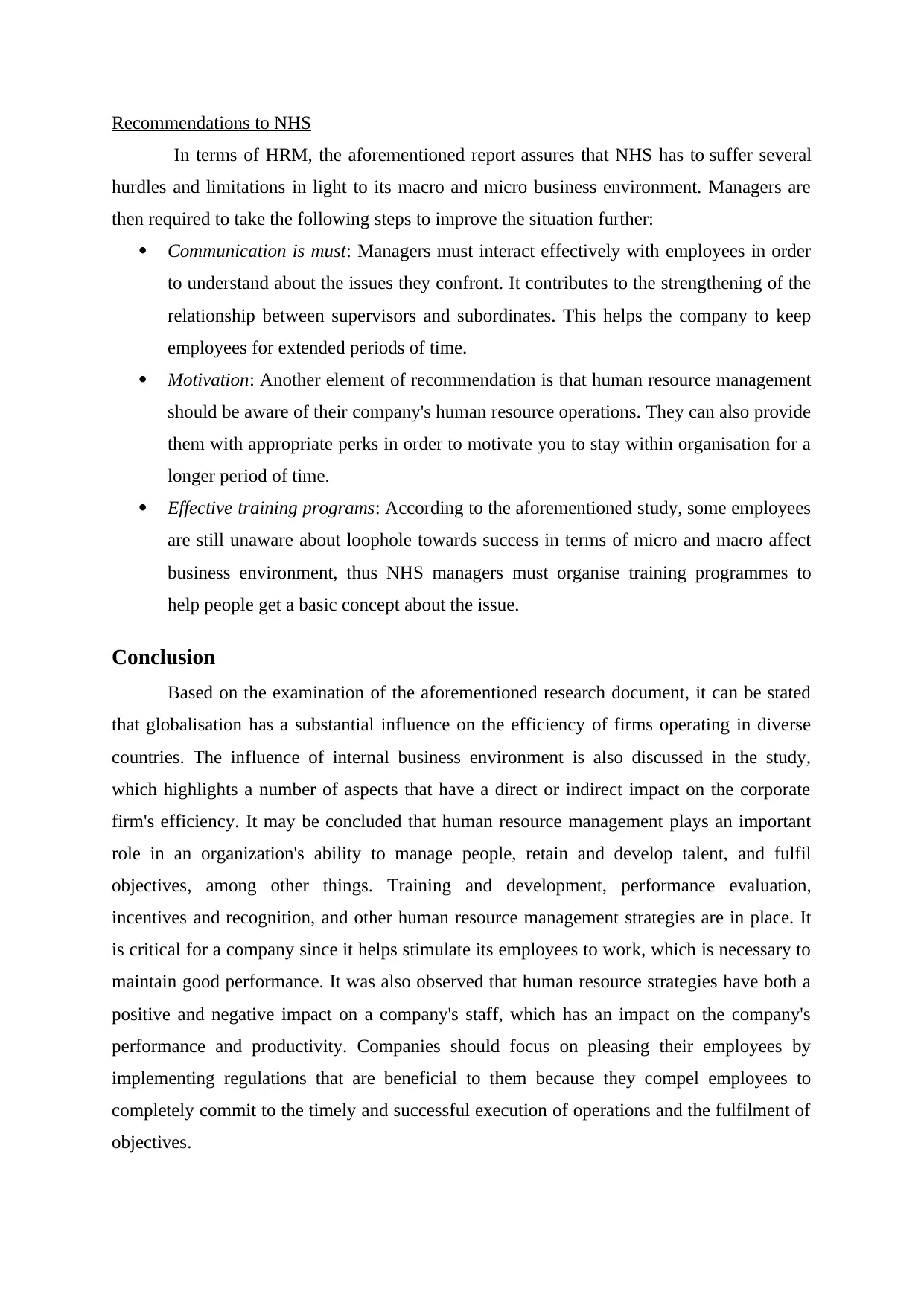
Recommendations to NHS
In terms of HRM, the aforementioned report assures that NHS has to suffer several
hurdles and limitations in light to its macro and micro business environment. Managers are
then required to take the following steps to improve the situation further:
Communication is must: Managers must interact effectively with employees in order
to understand about the issues they confront. It contributes to the strengthening of the
relationship between supervisors and subordinates. This helps the company to keep
employees for extended periods of time.
Motivation: Another element of recommendation is that human resource management
should be aware of their company's human resource operations. They can also provide
them with appropriate perks in order to motivate you to stay within organisation for a
longer period of time.
Effective training programs: According to the aforementioned study, some employees
are still unaware about loophole towards success in terms of micro and macro affect
business environment, thus NHS managers must organise training programmes to
help people get a basic concept about the issue.
Conclusion
Based on the examination of the aforementioned research document, it can be stated
that globalisation has a substantial influence on the efficiency of firms operating in diverse
countries. The influence of internal business environment is also discussed in the study,
which highlights a number of aspects that have a direct or indirect impact on the corporate
firm's efficiency. It may be concluded that human resource management plays an important
role in an organization's ability to manage people, retain and develop talent, and fulfil
objectives, among other things. Training and development, performance evaluation,
incentives and recognition, and other human resource management strategies are in place. It
is critical for a company since it helps stimulate its employees to work, which is necessary to
maintain good performance. It was also observed that human resource strategies have both a
positive and negative impact on a company's staff, which has an impact on the company's
performance and productivity. Companies should focus on pleasing their employees by
implementing regulations that are beneficial to them because they compel employees to
completely commit to the timely and successful execution of operations and the fulfilment of
objectives.
In terms of HRM, the aforementioned report assures that NHS has to suffer several
hurdles and limitations in light to its macro and micro business environment. Managers are
then required to take the following steps to improve the situation further:
Communication is must: Managers must interact effectively with employees in order
to understand about the issues they confront. It contributes to the strengthening of the
relationship between supervisors and subordinates. This helps the company to keep
employees for extended periods of time.
Motivation: Another element of recommendation is that human resource management
should be aware of their company's human resource operations. They can also provide
them with appropriate perks in order to motivate you to stay within organisation for a
longer period of time.
Effective training programs: According to the aforementioned study, some employees
are still unaware about loophole towards success in terms of micro and macro affect
business environment, thus NHS managers must organise training programmes to
help people get a basic concept about the issue.
Conclusion
Based on the examination of the aforementioned research document, it can be stated
that globalisation has a substantial influence on the efficiency of firms operating in diverse
countries. The influence of internal business environment is also discussed in the study,
which highlights a number of aspects that have a direct or indirect impact on the corporate
firm's efficiency. It may be concluded that human resource management plays an important
role in an organization's ability to manage people, retain and develop talent, and fulfil
objectives, among other things. Training and development, performance evaluation,
incentives and recognition, and other human resource management strategies are in place. It
is critical for a company since it helps stimulate its employees to work, which is necessary to
maintain good performance. It was also observed that human resource strategies have both a
positive and negative impact on a company's staff, which has an impact on the company's
performance and productivity. Companies should focus on pleasing their employees by
implementing regulations that are beneficial to them because they compel employees to
completely commit to the timely and successful execution of operations and the fulfilment of
objectives.
Secure Best Marks with AI Grader
Need help grading? Try our AI Grader for instant feedback on your assignments.
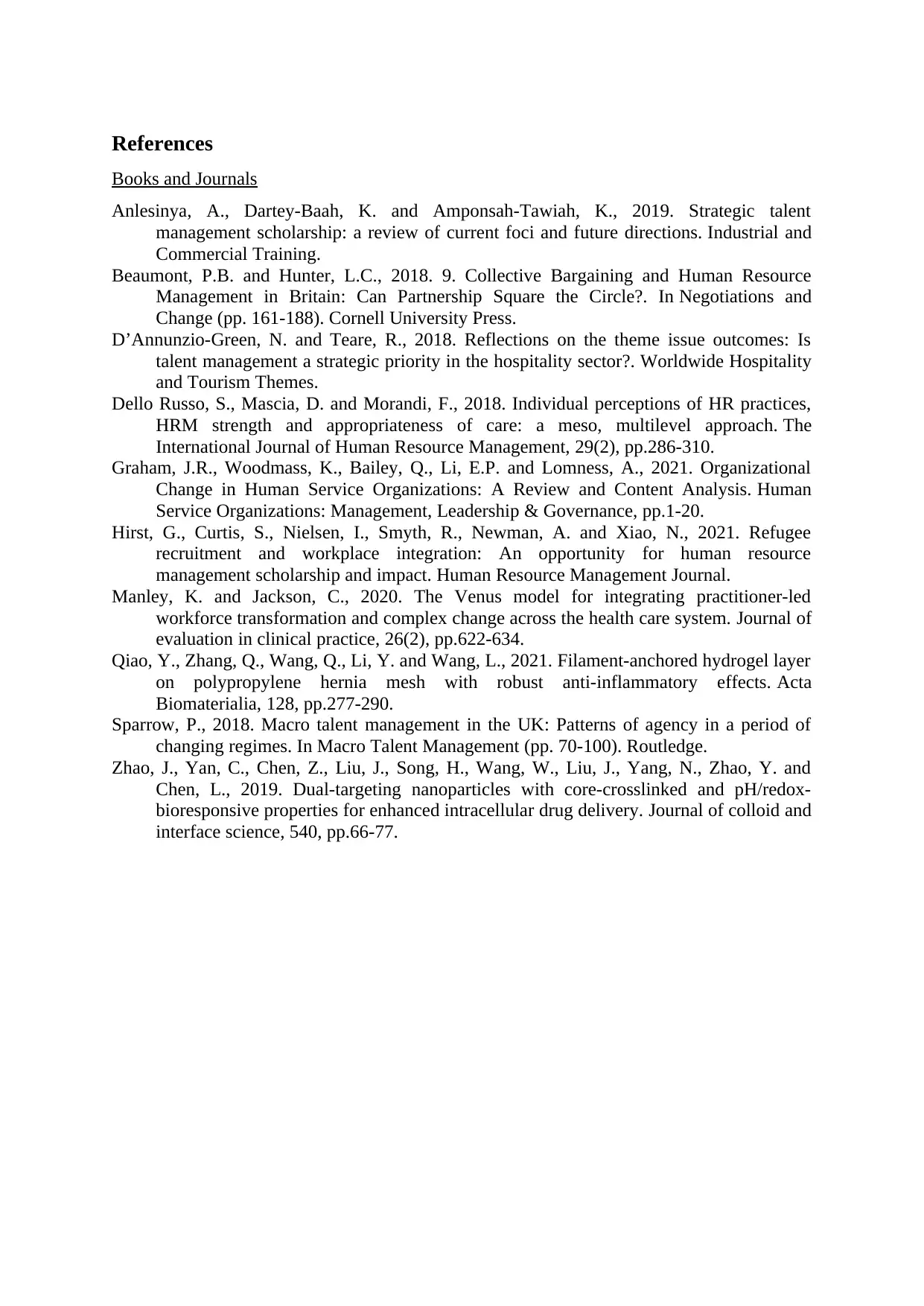
References
Books and Journals
Anlesinya, A., Dartey-Baah, K. and Amponsah-Tawiah, K., 2019. Strategic talent
management scholarship: a review of current foci and future directions. Industrial and
Commercial Training.
Beaumont, P.B. and Hunter, L.C., 2018. 9. Collective Bargaining and Human Resource
Management in Britain: Can Partnership Square the Circle?. In Negotiations and
Change (pp. 161-188). Cornell University Press.
D’Annunzio-Green, N. and Teare, R., 2018. Reflections on the theme issue outcomes: Is
talent management a strategic priority in the hospitality sector?. Worldwide Hospitality
and Tourism Themes.
Dello Russo, S., Mascia, D. and Morandi, F., 2018. Individual perceptions of HR practices,
HRM strength and appropriateness of care: a meso, multilevel approach. The
International Journal of Human Resource Management, 29(2), pp.286-310.
Graham, J.R., Woodmass, K., Bailey, Q., Li, E.P. and Lomness, A., 2021. Organizational
Change in Human Service Organizations: A Review and Content Analysis. Human
Service Organizations: Management, Leadership & Governance, pp.1-20.
Hirst, G., Curtis, S., Nielsen, I., Smyth, R., Newman, A. and Xiao, N., 2021. Refugee
recruitment and workplace integration: An opportunity for human resource
management scholarship and impact. Human Resource Management Journal.
Manley, K. and Jackson, C., 2020. The Venus model for integrating practitioner‐led
workforce transformation and complex change across the health care system. Journal of
evaluation in clinical practice, 26(2), pp.622-634.
Qiao, Y., Zhang, Q., Wang, Q., Li, Y. and Wang, L., 2021. Filament-anchored hydrogel layer
on polypropylene hernia mesh with robust anti-inflammatory effects. Acta
Biomaterialia, 128, pp.277-290.
Sparrow, P., 2018. Macro talent management in the UK: Patterns of agency in a period of
changing regimes. In Macro Talent Management (pp. 70-100). Routledge.
Zhao, J., Yan, C., Chen, Z., Liu, J., Song, H., Wang, W., Liu, J., Yang, N., Zhao, Y. and
Chen, L., 2019. Dual-targeting nanoparticles with core-crosslinked and pH/redox-
bioresponsive properties for enhanced intracellular drug delivery. Journal of colloid and
interface science, 540, pp.66-77.
Books and Journals
Anlesinya, A., Dartey-Baah, K. and Amponsah-Tawiah, K., 2019. Strategic talent
management scholarship: a review of current foci and future directions. Industrial and
Commercial Training.
Beaumont, P.B. and Hunter, L.C., 2018. 9. Collective Bargaining and Human Resource
Management in Britain: Can Partnership Square the Circle?. In Negotiations and
Change (pp. 161-188). Cornell University Press.
D’Annunzio-Green, N. and Teare, R., 2018. Reflections on the theme issue outcomes: Is
talent management a strategic priority in the hospitality sector?. Worldwide Hospitality
and Tourism Themes.
Dello Russo, S., Mascia, D. and Morandi, F., 2018. Individual perceptions of HR practices,
HRM strength and appropriateness of care: a meso, multilevel approach. The
International Journal of Human Resource Management, 29(2), pp.286-310.
Graham, J.R., Woodmass, K., Bailey, Q., Li, E.P. and Lomness, A., 2021. Organizational
Change in Human Service Organizations: A Review and Content Analysis. Human
Service Organizations: Management, Leadership & Governance, pp.1-20.
Hirst, G., Curtis, S., Nielsen, I., Smyth, R., Newman, A. and Xiao, N., 2021. Refugee
recruitment and workplace integration: An opportunity for human resource
management scholarship and impact. Human Resource Management Journal.
Manley, K. and Jackson, C., 2020. The Venus model for integrating practitioner‐led
workforce transformation and complex change across the health care system. Journal of
evaluation in clinical practice, 26(2), pp.622-634.
Qiao, Y., Zhang, Q., Wang, Q., Li, Y. and Wang, L., 2021. Filament-anchored hydrogel layer
on polypropylene hernia mesh with robust anti-inflammatory effects. Acta
Biomaterialia, 128, pp.277-290.
Sparrow, P., 2018. Macro talent management in the UK: Patterns of agency in a period of
changing regimes. In Macro Talent Management (pp. 70-100). Routledge.
Zhao, J., Yan, C., Chen, Z., Liu, J., Song, H., Wang, W., Liu, J., Yang, N., Zhao, Y. and
Chen, L., 2019. Dual-targeting nanoparticles with core-crosslinked and pH/redox-
bioresponsive properties for enhanced intracellular drug delivery. Journal of colloid and
interface science, 540, pp.66-77.
1 out of 11
Related Documents
Your All-in-One AI-Powered Toolkit for Academic Success.
+13062052269
info@desklib.com
Available 24*7 on WhatsApp / Email
![[object Object]](/_next/static/media/star-bottom.7253800d.svg)
Unlock your academic potential
© 2024 | Zucol Services PVT LTD | All rights reserved.





